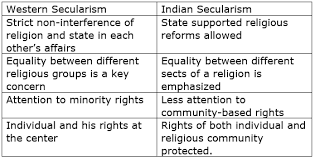French Secularism | 07 Nov 2020
This article is based on “French classroom lessons” which was published in The Indian Express on 07/11/2020. It talks about the issues pertaining to the France model of secularism.
The latest crisis in France which emanated from the killing of a middle-school history teacher and followed up killings in French city of Nice has once again brought France's unique model of secularism into spotlight.
French laïcité, or secularism is better understood as a project of social cohesion and a key component of French citizenship. It encompasses not simply the formal separation of Church and State, but also the removal of religious values from the public space and their replacement with secular values such as liberty, equality, and fraternity.
This has caused social tension in French society and pushes the country to re-articulate its liberal values in a way that lessens its internal tensions. In this pursuit France can derive inspiration from Indian model of secularism.
Evolution of French Secularism
- The French model of secularism was developed during the French Revolution in 1905, when a French law separated the church and the state, thus marking the beginnings of French secularism (laïcité) in modern times.
- Laïcité” derives from the French term for laity—non-clergy or lay people.
- Broadly, the idea refers to the freedom of citizens and of public institutions from the influence of organized religion.
- The new Act defined three essential principles: Freedom of conscience, equality in law for spiritual and religious belief, and neutrality of political power.
- This secular outlook was strengthened by another constitutional right — the right to freedom of expression.
- In pursuance of this, French school teachers today are thus actively encouraged to foster a fearless spirit of inquiry, regardless of religion or any other hindrance.
- This French secular tradition was further fortified in the face of new challenges posed by immigration, largely from former French colonies.
- In 2004, another law was promulgated, banning schoolchildren from wearing any overt signs or clothes that would betray their religious affiliation.
- This was an effort to create a unique school space, where everyone would look equal and “religiously anonymous” — no crosses, no headscarves or burqas, no turbans, no Jewish kippahs (skullcaps).
Challenges Related to French Model of Secularism
- Changed Demographics: In early 20th-century France—a fairly homogeneous, Christian nation. French model of secularism was a straightforward attempt to protect the government from the sway of the Catholic Church.
- However, modern France is a more heterogeneous and multi-religious society. Thus, the current model of French secularism is getting into conflict with rights of minorities.
- Against Freedom of Religion: Critics of laïcité argue that it is a disguised form of anti-clericalism and infringement on individual right to religious expression, and that, instead of promoting freedom of thought and freedom of religion, it prevents the believer from observing his or her religion.
- Undermining Civil Liberties: Laïcité is also criticized for increasing police powers that could endanger respect for civil liberties.
- Prompting Radicalization: Laïcité is unintelligible and even shocking to religious minorities, who view it as an injunction to abandon their religion.
- Instead of enhancing social harmony, it may actually be exacerbating religious and racial tensions.
Inspiration that France Can Draw From Indian Secularism
French integration model, which is enshrined in the country’s Constitution appears to be not in synergy with the emergence of multiculturalism. In this context, France can imbibe the philosophy of Indian Secularism. Following are philosophical underpinning of Indian model of Secularism:
- Sarva Dharma Sambhava: Indian philosophy of secularism is related to “Sarva Dharma Sambhava” (literally it means that the destination of the paths followed by all religions is the same, though the paths themselves may be different) which means equal respect to all religions.
- Positive secularism: This concept, embraced and promoted by personalities like Vivekananda and Mahatma Gandhi is called ‘Positive secularism’ that reflects the dominant ethos of Indian culture.
- Religious Plurality: Indian secularism is not an end in itself but a means to address religious plurality and sought to achieve peaceful coexistence of different religions.
- Protection of Minority Rights: Indian Secularism deals not only with the religious freedom of individuals but also with the religious freedom of minority communities.
Conclusion
In a pluralistic society, the best approach to nurture secularism is to expand religious freedom rather than strictly practicing state neutrality. Thus, it is incumbent on French society to ensure value-education that makes the younger generation understand and appreciate not only its own religious traditions but also those of the other religions in the country.
|
Drishti Mains Question “Toleration, not suppression, of difference is the only policy that’s really compatible with a heterogeneous society”. Discuss the statement in light of issues related to French model of Secularism. |
This editorial is based on “Worst Over for the Economy, Not Covid” which was published in The Economic Times on November 06th, 2020. Now watch this on our Youtube channel.

